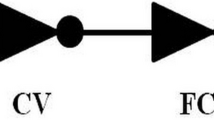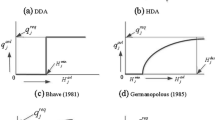Abstract
In the last three decades, many researchers have proposed different models for water distribution network (WDN) hydraulic analysis by head-driven analysis (HDA). By considering a pressure-discharge relationship (PDR), head-driven analysis (HDA) can avoid deviation caused by traditional demand-driven analysis (DDA) under abnormal conditions. Generally, there are three types of HDA models: 1) models achieved by embedding a PDR into DDA, 2) models using EPANET structures such as emitter or tank to take place of PDR, 3) models aiming at modifying nodal outflows to satisfy PDR based on EPANET. Among these models, modifying nodal outflows is flexible to simulate network with different PDRs and specify parameters related to PDR. Most of the models use iterative algorithms to solve HDA problems; however, present ways to ensure convergence of models are still inadequate. The purpose of this paper is to present a new way to meet the iterative convergence when modifying nodal outflows based on PDR and leakage. This new methodology has been incorporated into the hydraulic network solver EPANET and is formalized algorithmically as EPANET-IMNO. Then two typical networks are used to test EPANET-IMNO, and the results demonstrate that EPANET-IMNO can converge well and applied successfully both in static simulation and extended period simulation. Different pressure deficiency conditions are tested to further confirm the flexibility and the convergence of EPANET-IMNO. Furthermore, quality analysis results back that pressure reduction can be a practical way in contamination accident response.










Similar content being viewed by others
References
Ang WK, Jowitt PW (2006) Solution for water distribution systems under pressure-deficient conditions. J Water Resour Plan Manag 132:175–182
Baek CW, Jun HD, Kim JH (2010) Development of a PDA model for water distribution systems using harmony search algorithm. KSCE J Civ Eng 14:613–625
Cheung PB, Van Zyl JE, Reis LFR (2005) Extension of Epanet for pressure driven demand modeling in water distribution system, 8th international conference on computing and control for the water industry, CCWI 2005, September 5, 2005 - September 7, 2005. Centre for Water Systems, Exeter, United kingdom, p. Advantica; Black and Veatch; DHI Water and Environment; et al.; LogicaCMG; SEAMS
Fujiwara O, Li J (1998) Reliability analysis of water distribution networks in consideration of equity, redistribution, and pressure-dependent demand. Water Resour Res 34:1843–1850
Germanopoulos G (1985) A technical note on the inclusion of pressure dependent demand and leakage terms in water supply network models. Civ Eng Syst 2:171–179
Giustolisi O, Kapelan Z, Savic D (2008a) Extended period simulation analysis considering valve shutdowns. J Water Resour Plan Manag 134:527–537
Giustolisi O, Savic D, Kapelan Z (2008b) Pressure-driven demand and leakage simulation for water distribution networks. J Hydraul Eng 134:626–635
Guidolin M, Burovskiy P, Kapelan Z, Savić DA (2010) CWSNet: An object-oriented toolkit for water distribution system simulations, WDSA 2010 conference
Hayuti MH, Burrows R, Naga D (2007) Modelling water distribution systems with deficient pressure. Proc Inst Civil Engineers: Water Manag 160:215–224
Liu J, Yu G (2013) Iterative methodology of pressure-dependent demand based on EPANET for pressure-deficient water distribution analysis. J Water Resour Plan Manag 139:34–44
Liu J, Yu G, Savic D (2011) Deficient-network simulation considering pressure-dependent demand, international conference on pipelines and trenchless technology 2011: sustainable solutions for water, sewer, gas, and oil pipelines, ICPTT 2011, October 26, 2011 - October 29, 2011. American Society of Civil Engineers (ASCE), Beijing, China, pp. 886–900
Moosavian N, Jaefarzadeh MR (2013) pressure-driven demand and leakage simulation for pipe networks using differential evolution. World J Engineering Technol, 49–58
Ozger SS, Mays LW (2003) A semi-pressure-driven approach to reliability assessment of water distribution networks. Arizona State University
Pathirana A (2010) EPANET2 desktop application for pressure driven demand modeling. Water Distribution System Analysis
Rasekh A, Brumbelow K (2014) Drinking water distribution systems contamination management to reduce public health impacts and system service interruptions. Environ Model Softw 51:12–25
Rossman LA (2000) EPANET 2: users manual
Shirzad A, Tabesh M, Farmani R, Mohammadi M (2013) Pressure-discharge relations with application to head-driven simulation of water distribution networks. J Water Resour Plan Manag 139:660–670
Siew C, Tanyimboh TT (2012) Pressure-dependent EPANET extension: pressure-dependent demands, 12th annual international conference on water distribution systems analysis 2010, WDSA 2010, September 12, 2010 - September 15, 2010. American Society of Civil Engineers (ASCE), Tucson, AZ, United states, pp. 75–84
Srinivasa Reddy L, Elango K (1989) Analysis of water distribution networks with head-dependent outlets. Civ Eng Syst 6:102–110
Tabesh M (1998) Implications of the pressure dependency of outflows on data management, mathematical modelling and reliability assessment of water distribution systems. Liverpool University
Tabesh M, Tanyimboh TT, Burrows R (2004) Head driven simulation based reliability assessment of water supply networks, world water and environmental resources congress 2001, May 20, 2001 - May 24, 2001. American Society of Civil Engineers, Orlando
Tabesh M, Shirzad A, Arefkhani V, Mani A (2014) A comparative study between the modified and available demand driven based models for head driven analysis of water distribution networks. Urban Water J 11:221–230
Tsakiris G, Spiliotis M (2014) A Newton–Raphson analysis of urban water systems based on nodal head-driven outflow. Eur J Environ Civil Eng 18:882–896
Wagner JM, Shamir U, Marks DH (1988) Water distribution reliability: simulation methods. J Water Resour Plan Manag 114:276–294
Wu ZY, Wang RH, Walski TM, Yang SY, Bowdler D, Baggett CC (2009) Extended global-gradient algorithm for pressure-dependent water distribution analysis. J Water Resources Planning Manag -ASCE 135:13–22
Acknowledgments
This work was financially supported by National Natural Science Foundation of China (Projects No. 51378374, 51478326), and Fundamental Research Funds for the Central Universities of China (No. 0400219309).
Author information
Authors and Affiliations
Corresponding author
Ethics declarations
Ethical Statement
This research was supported by National Natural Science Foundation of China (Grant No. 51478326 and 51378374). The authors declare that they have no conflict of interest. All procedures performed in studies involving human participants were in accordance with the ethical standards of the institutional and/or national research committee and with the 1964 Helsinki declaration and its later amendments or comparable ethical standards. This article does not contain any studies with animals performed by any of the authors. Informed consent was obtained from all individual participants included in the study.
Rights and permissions
About this article
Cite this article
He, P., Tao, T., Xin, K. et al. Modelling Water Distribution Systems with Deficient Pressure: An Improved Iterative Methodology. Water Resour Manage 30, 593–606 (2016). https://doi.org/10.1007/s11269-015-1179-4
Received:
Accepted:
Published:
Issue Date:
DOI: https://doi.org/10.1007/s11269-015-1179-4




